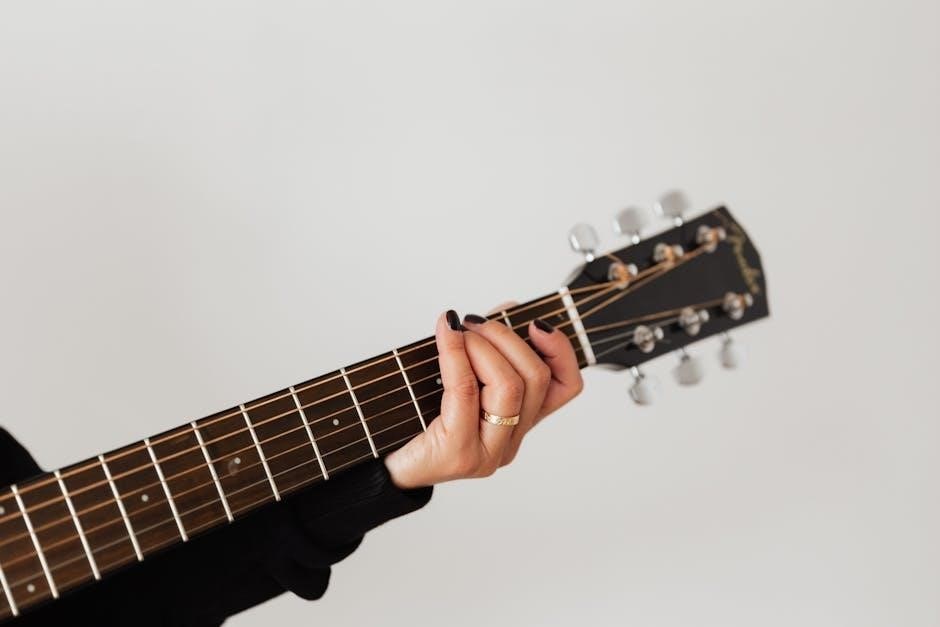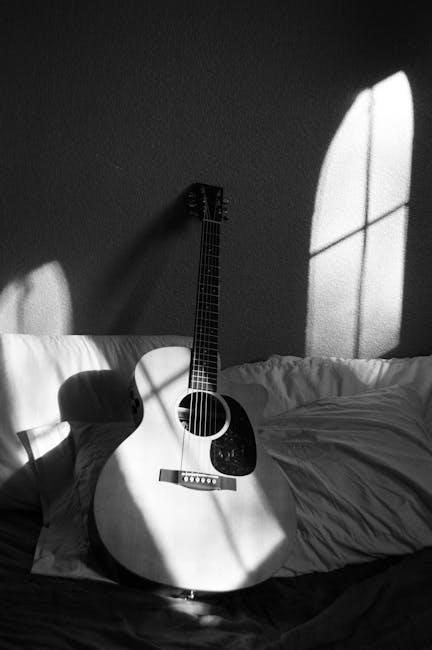A comprehensive guide to mastering barre chords, this PDF chart offers clear, organized visuals for learning and practicing various chord shapes across the fretboard.
Overview of Bar Chords and Their Importance
Bar chords are fundamental to guitar playing, offering versatility and a wide range of tonal options. They allow musicians to play chords across the fretboard, enabling transposition and complex harmonies. Unlike open chords, bar chords provide a full, rich sound and are essential for various musical styles. Mastering bar chords enhances a guitarist’s ability to play smoothly and professionally. They are particularly useful for songs requiring chord progressions beyond basic open chords. A bar chord chart PDF simplifies learning, providing clear visuals for finger placement and chord shapes. This makes it an invaluable tool for both beginners and advanced players aiming to expand their musical repertoire.
- Bar chords are movable and versatile.
- They enable playing chords in multiple keys.
- Essential for advanced guitar techniques and songwriting.
- A bar chord chart PDF organizes chords for easy reference.
Why Use a Bar Chords Chart?
A bar chords chart is an essential tool for guitarists, providing a visual guide to mastering barre chords. It simplifies learning by organizing chords systematically, making it easier to locate and play them across the fretboard. With a chart, you can quickly identify finger placements, understand chord shapes, and practice effectively. This resource is particularly useful for beginners struggling with barre chords, as it offers a clear roadmap for progression. Advanced players also benefit from its convenience and comprehensive coverage of movable shapes and variations. A bar chords chart is a time-saving, versatile tool that enhances both practice and performance.
- Provides clear visuals for finger placement and chord shapes.
- Helps master movable barre chords efficiently.
- Useful for both beginners and advanced players.
- Offers quick reference for practice and performance.
How to Download and Use a Bar Chords Chart in PDF Format
Downloading a bar chords chart in PDF format is straightforward. Visit reputable guitar resources or educational websites, where free and printable charts are often available. Once downloaded, print the chart for easy reference. Use it to identify chord shapes, finger placements, and fret positions. The chart typically includes movable barre chords, allowing you to play various chords by sliding the shape up and down the neck. Practice referencing the chart to build muscle memory and improve your technique. It’s a handy tool for both beginners and advanced players to master barre chords efficiently.
- Download from trusted guitar education websites.
- Print for easy practice and reference.
- Use to identify chord shapes and finger placements.
- Practice movable shapes to expand your chord vocabulary.

What Are Bar Chords?
Bar chords, or barre chords, involve using the index finger to press all strings across the fretboard, creating movable chord shapes. They allow versatile, full-sounding chords anywhere on the guitar.
Definition and Basic Concept
Bar chords, short for barre chords, are guitar chords that require the player to press multiple strings across the fretboard using the index finger. This technique allows for the creation of chords in various positions along the neck, providing a movable and versatile way to play chords. The basic concept involves placing the index finger flat across all six strings at a specific fret, effectively substituting for the guitar’s nut. This method enables the same chord shape to be played in different keys by sliding up or down the neck, making bar chords an essential skill for guitarists aiming to expand their musical range and versatility.
How Bar Chords Differ from Open Chords
Bar chords differ from open chords in that they do not use open strings. Instead, they rely on the index finger to press all strings across a fret, creating a movable chord shape. Unlike open chords, which are fixed and limited to specific keys, bar chords can be slid up and down the neck to play the same chord in different keys. This versatility comes with a trade-off, as bar chords often require more finger strength and precision. Open chords, by contrast, are simpler and brighter but lack the flexibility of bar chords, making them suitable for different musical contexts.

The Structure of a Guitar Bar Chords Chart
A bar chords chart visually organizes chords with strings as rows and frets as columns, using dots and bars to indicate finger placements for clear, intuitive learning.
Understanding the Layout of the Chart
The layout of a bar chords chart is designed to mirror the guitar neck, with vertical lines representing strings and horizontal lines for frets. Each dot indicates where fingers should press the strings. The chart typically starts from the first fret and moves upward, covering all essential chords. Color coding or symbols may highlight the root note, making it easier to identify chord shapes. This visual structure allows guitarists to quickly locate and replicate barre chords, enhancing their learning and practice efficiency significantly. The chart’s clarity ensures that even complex chords are accessible and easy to understand.
Reading the Chart: Strings, Frets, and Finger Positions
The chart displays strings vertically and frets horizontally, with dots or numbers indicating finger placements. Each string corresponds to a line, while fret numbers show where to press down. Open circles represent open strings, and filled circles indicate pressed notes. The root note is often highlighted in a different color or symbol for easy identification. Finger numbers (1-4) are usually placed above or beside the dots, guiding which fingers to use. By aligning the chart with your guitar’s tuning, you can replicate the shapes accurately. This system allows guitarists to decode chord shapes efficiently, making practice and performance more accessible.

Major Bar Chords on the Guitar
Mastering major bar chords enhances your versatility as a guitarist, offering full, rich sounds. These chords are movable and form the foundation for various keys and styles.
E Major Bar Chord Shape
The E Major bar chord shape is one of the most essential movable chord forms on the guitar. It is built from the E Major open chord, with the addition of a barre across all six strings. To play this shape, place your index finger across the fretboard at the desired fret, ensuring all strings are pressed firmly. The remaining fingers should form the E Major open chord shape above the barre. This chord is versatile and can be moved up and down the neck to play Major chords in different keys. Proper finger placement and strength are crucial for clean, clear tones. Common issues include muting strings or incomplete barres, so practice is key to mastery.
- Index finger: Barre across all strings.
- Ring and middle fingers: Form the E Major shape on the higher strings.
- Ensure firm pressure to avoid muted notes.
A Major Bar Chord Shape
The A Major bar chord shape is a fundamental movable chord form, derived from the A Major open chord. To play it, place your index finger across the fretboard at the desired fret, barring all six strings. Your middle, ring, and pinky fingers should form the A Major open chord shape above the barre. This shape allows you to play Major chords in various keys by sliding it up and down the neck. Proper finger placement and pressure are essential for clear tones. Beginners often find this shape challenging, but consistent practice improves strength and accuracy.
- Index finger: Barre across all strings firmly.
- Middle, ring, and pinky: Form the A Major shape on the higher strings.
- Adjust finger placement to avoid muted strings.

Minor Bar Chords on the Guitar
Minor bar chords are movable shapes based on the E minor open chord, creating somber, melancholic sounds. They include minor and minor 7th variations, essential for versatile playing.
E Minor Bar Chord Shape
The E minor bar chord is a foundational movable shape derived from the open E minor chord. It is played by barring the index finger across all six strings at a specific fret, with the remaining fingers completing the chord shape. This chord is versatile and widely used in various musical styles, offering a rich, full sound. The E minor bar chord shape is particularly useful for creating minor progressions and can be moved up and down the neck to form different minor chords. It is a cornerstone for players aiming to expand their chord vocabulary and enhance their musical expression.
A Minor Bar Chord Shape
The A minor bar chord is another essential movable shape, derived from the open A minor chord. It involves barring the index finger across multiple strings at a specific fret, with the remaining fingers forming the chord structure. This shape allows for a smooth transition between minor chords across the fretboard. The A minor bar chord is frequently used in various genres, providing a somber yet rich tonal quality. By mastering this shape, guitarists can easily adapt to different keys and enhance their ability to play complex chord progressions with confidence and precision.

Seventh Bar Chords on the Guitar
Seventh bar chords add complexity and emotion to music, combining a root, third, fifth, and seventh. They are movable and widely used in jazz and blues, offering rich tonal depth.
Major 7th Bar Chords
Major 7th bar chords blend the brightness of major chords with the sophistication of a seventh. They are constructed with a root, major third, perfect fifth, and major seventh. Common shapes include the E and A major 7th forms, which can be moved up the neck for different keys. These chords are versatile, adding rich, expansive tones to melodies and harmonies. They are essential for jazz, pop, and fusion styles, providing a lush, modern sound. Practice these chords to enhance your musical versatility and depth. Regular practice will improve your finger strength and accuracy.
Minor 7th Bar Chords
Minor 7th bar chords are versatile and rich, combining a root, minor third, perfect fifth, and minor seventh. They are commonly used in jazz, rock, and pop for their emotive, melancholic sound. The E and A minor 7th bar chord shapes are foundational, with the E shape being the most frequently used. These chords are movable, allowing players to create minor 7th chords across the fretboard. Start with the E minor 7th shape, as it aligns with the standard tuning of the guitar. Practice finger placement carefully to ensure clarity and avoid muffled strings. Regular practice will build strength and precision, enhancing your ability to play these chords smoothly.

Other Variations of Bar Chords
Explore diminished, augmented, and power chords, which add unique textures to your music. These variations expand your tonal palette and enhance your guitar playing versatility.
Diminished and Augmented Bar Chords
Diminished and augmented bar chords add unique sonic flavors to your playing. A diminished bar chord features a root, minor third, and diminished fifth, creating a tense, unstable sound. Augmented bar chords include a root, major third, and augmented fifth, producing a bright, expansive tone. Both are movable and can be played across the fretboard by adjusting the barre position. These chords are versatile for jazz, rock, and experimental music. Learning these variations expands your musical expression and enhances your ability to play complex harmonies. Use the PDF chart to master these shapes and incorporate them into your compositions or improvisations.
Power Chords and Movable Shapes
Power chords are essential for their simplicity and versatility, consisting of a root note and a perfect fifth. They are often used in rock, punk, and metal music. Movable barre chord shapes, such as the E and A minor forms, allow players to transpose chords across the fretboard. These shapes are foundational for creating full, rich sounds. By mastering power chords and movable shapes, guitaristscan easily transition between keys and expand their harmonic palette. The PDF chart provides clear diagrams for these chord forms, making them accessible for practice and performance. Regular practice will enhance your ability to play cleanly and confidently.

Mastering Bar Chords: Tips and Tricks
Start with slower tempos, use a metronome, and focus on clean, clear notes. Warm up with finger exercises to build strength and dexterity. Use a tuner for accuracy and practice chord transitions smoothly. Consistency is key—dedicate daily time to bar chord practice. Gradually increase difficulty to build confidence and mastery.
Finger Placement and Strength
Proper finger placement is crucial for clean bar chords. Place your index finger close to the fret, directly behind the strings for optimal pressure. Build finger strength through exercises like chromatic scales and finger stretches. Use a firm yet controlled grip to avoid muting adjacent strings. Ensure your fingers are positioned to press all strings evenly, especially the lower ones, which require more pressure. Strengthen your index finger separately, as it bears the most weight in bar chords. Regular practice will improve dexterity and endurance, making bar chords easier to play cleanly and confidently.
Practice Exercises for Bar Chords
Start with slow chromatic scales to build finger strength and dexterity. Practice switching between open chords and their barre equivalents to develop muscle memory. Focus on finger stretches to improve reach and accuracy. Begin with simpler shapes like E and A, gradually progressing to more complex ones. Use a metronome to practice clean chord changes at varying tempos. Incorporate barre chords into simple songs to apply them musically. Dedicate time daily to strengthen your index finger and improve barre technique. Consistency and patience are key to mastering these foundational exercises.

Common Mistakes to Avoid
Improper finger placement and insufficient pressure often lead to muted strings. Ensure the index finger bars correctly and avoid overlapping adjacent strings to maintain clear, clean tones.
Troubleshooting Bar Chord Issues
Common issues with bar chords include buzzing strings, muted notes, or poor tone. These problems often arise from improper finger placement or insufficient pressure. Ensure your index finger bars all strings firmly and evenly. If strings buzz, check your guitar’s action height or adjust your finger position. Avoid placing fingers too close to the fret, as this can mute strings. Additionally, build finger strength gradually to avoid fatigue. Regular practice and proper technique will help overcome these challenges and improve your bar chord playing over time.

Resources for Downloading Bar Chords Chart PDF
Find free, printable bar chord charts on websites like Guitarhabits.com and Elmore Music. These resources offer comprehensive guides with major, minor, and seventh chord shapes for easy practice.
Recommended Websites for Free and Printable Charts
Several websites offer high-quality, free, and printable bar chord charts. Guitarhabits.com provides detailed PDFs for major, minor, and seventh chords. Elmore Music offers comprehensive guides, including movable shapes. Beginner Guitar features essential charts for quick learning. Ukulele 5th String includes unique resources for versatile playing. These sites ensure access to structured, easy-to-read charts, perfect for all skill levels. Downloadable and printable formats make practice convenient. Explore these resources to enhance your bar chord mastery with clear, organized layouts.
Advanced Techniques with Bar Chords
Mastering bar chords opens doors to complex techniques like movable shapes, seventh chords, and improvisation. Explore advanced applications in songwriting and improvisation with detailed chord charts.
Using Bar Chords in Songwriting and Improvisation
Bar chords are indispensable in songwriting and improvisation, offering versatility and depth. By using movable shapes, musicians can craft rich harmonies and transitions, enhancing emotional expression in their music. The ability to play complex chords across the fretboard allows for dynamic compositions and spontaneous creativity during improvisation sessions. A well-organized bar chord chart PDF serves as a valuable reference, enabling guitarists to explore various chord progressions and experiment with different musical styles seamlessly. This tool is essential for taking guitar playing to the next artistic level.
Mastering bar chords unlocks endless musical possibilities, and a PDF chart is an invaluable tool for learning and reference, helping guitarists achieve proficiency and artistic expression.
Final Thoughts on Bar Chords and Their Role in Guitar Playing
Bar chords are a cornerstone of guitar playing, offering versatility and depth to any musician’s repertoire. While they can be challenging to master, their ability to unlock complex chord shapes and progressions makes them invaluable. A PDF chart serves as an essential resource, providing clear visuals for learning and reference. By dedicating time to practice and using the chart as a guide, guitarists can overcome common hurdles like fingering and string pressure. Ultimately, bar chords empower players to explore a wide range of musical styles, from rock to jazz, and are a key step in advancing from basic chords to more sophisticated sounds.

Be First to Comment